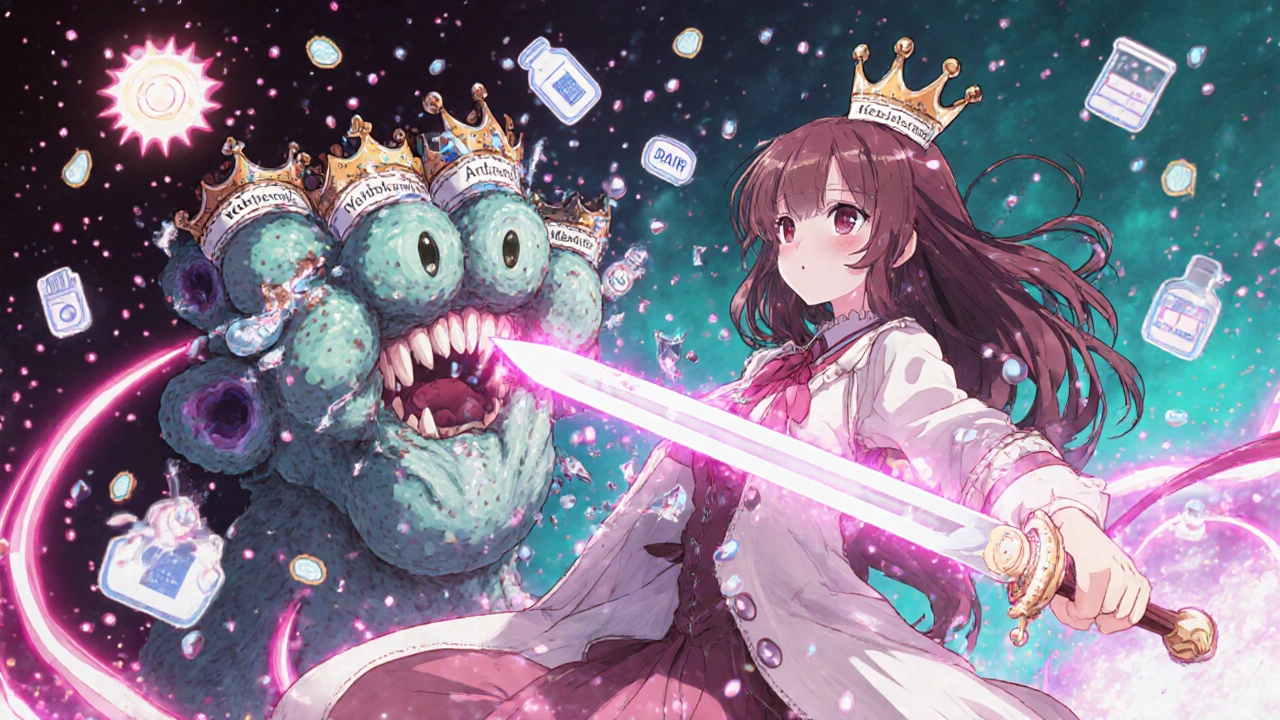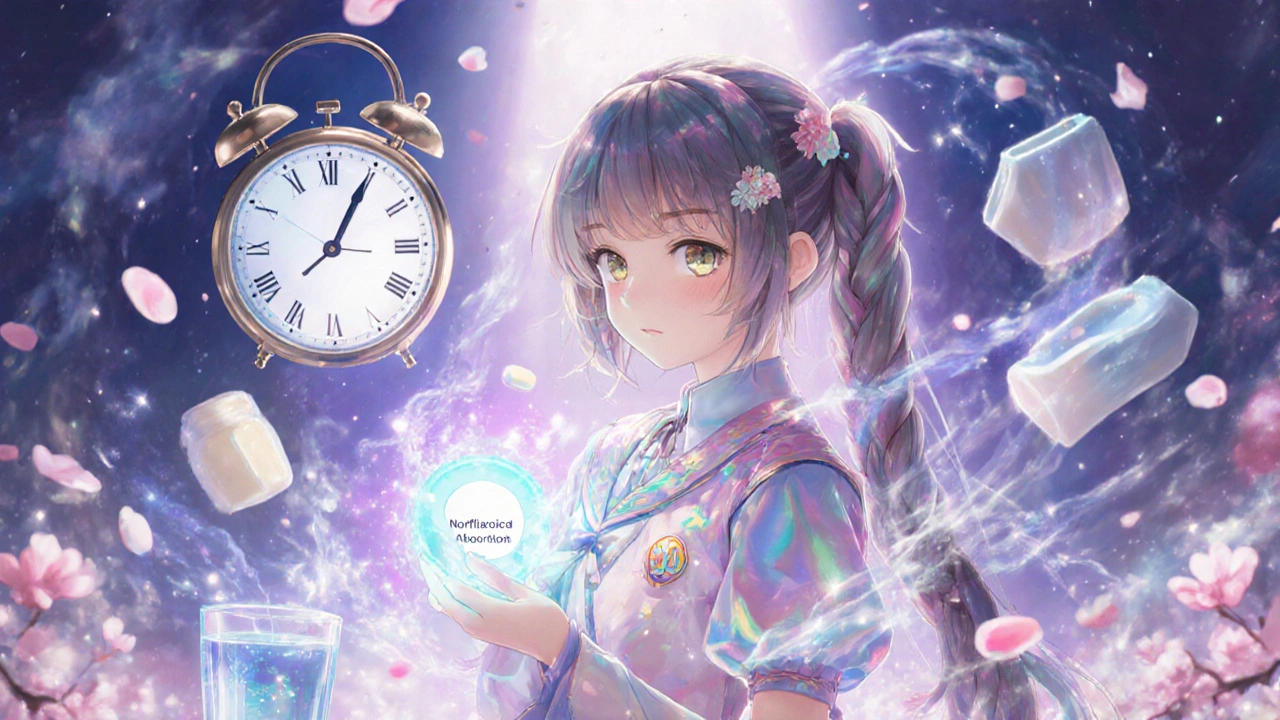Norfloxacin is an antibiotic used to treat bacterial infections, especially urinary tract infections (UTIs), prostate infections, and some types of gastrointestinal infections. It belongs to the fluoroquinolone class of antibiotics, which work by stopping bacteria from reproducing. But taking it wrong-whether too much, too little, or at the wrong time-can reduce its effectiveness or even lead to dangerous side effects. This guide breaks down exactly how to take norfloxacin safely and effectively based on current medical standards.
How Norfloxacin Works
Norfloxacin targets the enzymes bacteria need to copy their DNA and repair themselves. Without these functions, the bacteria die off. It’s especially effective against Gram-negative bacteria like Escherichia coli, Klebsiella pneumoniae, and Proteus mirabilis, which are common causes of UTIs. Unlike some antibiotics that need to be taken with food, norfloxacin works best on an empty stomach because food and dairy can block its absorption.
Standard Dosage for Adults
The usual dose for adults depends on the infection being treated. For uncomplicated urinary tract infections, the standard is 400 mg taken orally every 12 hours (twice a day) for 3 days. For more serious infections like complicated UTIs or chronic bacterial prostatitis, the dose increases to 400 mg twice daily for 7 to 28 days, depending on how the infection responds.
For travelers’ diarrhea caused by Enterotoxigenic E. coli, a 3-day course of 400 mg twice daily is typically prescribed. If symptoms don’t improve within 2-3 days, stop taking it and see a doctor-this could mean the infection isn’t bacterial or the bacteria are resistant.
When to Take Norfloxacin
Timing matters more than you might think. Take norfloxacin at least 1 hour before or 2 hours after meals. Dairy products like milk, yogurt, and cheese, as well as antacids containing magnesium, aluminum, or calcium, can bind to norfloxacin in your gut and stop it from being absorbed. That means your body gets less of the drug-and the infection might not clear up.
Also avoid taking it with iron supplements, zinc, or multivitamins that contain minerals. If you need these, space them out by at least 4 hours. Same goes for sucralfate and didanosine-commonly used for stomach ulcers or HIV. These interfere with absorption too.
What to Avoid While Taking Norfloxacin
Norfloxacin can make your skin more sensitive to sunlight. Even brief exposure can cause severe sunburn, blistering, or rash. Avoid tanning beds and limit direct sun exposure. Wear sunscreen and protective clothing if you must go outside.
Don’t drink alcohol while on norfloxacin. While it doesn’t cause a dangerous reaction like some antibiotics (e.g., metronidazole), alcohol can worsen side effects like dizziness, nausea, and headaches. It also puts extra stress on your liver, which is already processing the drug.
Some people report joint pain, tendon swelling, or even tendon rupture-especially if they’re over 60, taking steroids, or have had organ transplants. If you feel sudden pain, swelling, or snapping in your ankle, thigh, or shoulder, stop taking norfloxacin and get medical help right away.
Special Populations: Older Adults, Kids, and Pregnant Women
Norfloxacin is not approved for children under 18. Fluoroquinolones can damage growing cartilage and tendons. Unless there’s no other option for a life-threatening infection, doctors won’t prescribe it to kids.
For older adults, kidney function often declines with age. Since norfloxacin is cleared through the kidneys, your doctor may lower the dose or extend the time between doses if your creatinine clearance is below 50 mL/min. Always mention if you have kidney disease before starting this medication.
Pregnant women should avoid norfloxacin. Animal studies show it can harm developing fetuses, and there’s not enough safe data in humans. If you’re pregnant or planning to be, tell your doctor. For breastfeeding, the drug passes into breast milk in small amounts. While the risk to the baby is low, it’s still not recommended unless benefits clearly outweigh risks.

What to Do If You Miss a Dose
If you forget a dose, take it as soon as you remember. But if it’s almost time for your next dose, skip the missed one. Never double up to make up for it. Taking too much can lead to serious side effects like seizures, confusion, or irregular heartbeat.
Set phone alarms or use a pill organizer if you struggle to remember. Missing doses can let bacteria survive and become resistant. That means future infections could be harder to treat.
How Long Does It Take to Work?
Most people start feeling better within 1-2 days of starting norfloxacin. But don’t stop taking it just because symptoms disappear. You must finish the full course-even if you feel fine after 2 days. Stopping early is one of the top reasons antibiotic resistance develops.
If you don’t notice any improvement after 3 days, contact your doctor. You might need a different antibiotic or further testing to confirm the infection type.
Common Side Effects
Most side effects are mild and go away on their own:
- Nausea or upset stomach
- Diarrhea
- Headache
- Dizziness
- Insomnia or trouble sleeping
- Changes in taste
These usually fade after a few days. If they get worse or last longer than a week, talk to your doctor.
Serious Side Effects to Watch For
Call emergency services or go to the ER if you experience:
- Severe diarrhea with blood or mucus (could be C. diff infection)
- Signs of an allergic reaction: hives, swelling of face/lips/tongue, trouble breathing
- Sharp chest pain, fast or irregular heartbeat
- Severe dizziness, fainting
- Yellowing of skin or eyes (liver damage)
- Sudden joint or tendon pain, especially in heels
These are rare but serious. Norfloxacin carries a black box warning from the FDA for tendon rupture and nerve damage. Don’t ignore warning signs.

Drug Interactions to Know
Norfloxacin doesn’t play well with several common medications:
- Antacids, iron, zinc, or calcium supplements → reduce absorption
- Warfarin → increases bleeding risk
- Nonsteroidal anti-inflammatory drugs (NSAIDs) → higher chance of seizures
- Other QT-prolonging drugs (like amiodarone or certain antidepressants) → risk of dangerous heart rhythm
- Corticosteroids → increased risk of tendon rupture
Always give your doctor a full list of everything you take-including over-the-counter meds, vitamins, and herbal supplements.
Storage and Handling
Store norfloxacin tablets at room temperature (68-77°F or 20-25°C). Keep them away from moisture and direct light. Don’t store in the bathroom. Keep the bottle tightly closed and out of reach of children and pets.
Don’t keep expired medication. Dispose of unused pills properly-don’t flush them. Many pharmacies offer take-back programs.
When to Follow Up With Your Doctor
After finishing your course, watch for recurring symptoms. UTIs can come back, especially if the bacteria were resistant. If you have frequent UTIs, your doctor may recommend urine cultures or imaging tests to check for underlying issues like kidney stones or structural problems.
For men with prostatitis, follow-up is critical. Symptoms can linger even after bacteria are gone. Your doctor might check prostate-specific antigen (PSA) levels or do a repeat culture to confirm clearance.
Alternatives to Norfloxacin
Because of safety concerns and rising resistance, many doctors now prefer other antibiotics for UTIs:
- Trimethoprim-sulfamethoxazole (Bactrim) - first-line for uncomplicated UTIs
- Fosfomycin - single-dose treatment, low resistance
- Nitrofurantoin - good for bladder infections, not kidney infections
- Cephalexin - if you’re allergic to sulfa drugs
Norfloxacin is still useful when other options fail or for specific infections like prostatitis. But it’s no longer the go-to for simple UTIs in many clinics.
Final Tips for Safe Use
- Always take the full course, even if you feel better
- Avoid dairy, antacids, and mineral supplements within 2 hours of dosing
- Stay hydrated to help flush the drug through your kidneys
- Use sunscreen and avoid sun exposure
- Report tendon pain, nerve tingling, or heart symptoms immediately
- Never share antibiotics or use leftover pills for future infections
Norfloxacin can be effective-but only if used correctly. Misuse contributes to antibiotic resistance, which is one of the biggest public health threats today. Follow your doctor’s instructions, ask questions, and don’t assume you know what’s right based on past experiences.
Can I take norfloxacin with milk or yogurt?
No. Dairy products like milk, yogurt, and cheese contain calcium, which binds to norfloxacin and prevents your body from absorbing it. Take norfloxacin at least 2 hours before or after eating dairy or any calcium-fortified foods.
Is norfloxacin safe for older adults?
It can be, but with caution. Older adults often have reduced kidney function, which means the drug stays in the body longer. Doctors may lower the dose or extend the dosing interval. There’s also a higher risk of tendon rupture and nerve damage in people over 60, especially if they’re on steroids.
How long does norfloxacin stay in your system?
The half-life of norfloxacin is about 3 to 4 hours in healthy adults. That means most of it is cleared from your body within 24 hours. But if you have kidney problems, it can stay longer-up to 12 hours or more. This is why dose adjustments are needed for people with reduced kidney function.
Can norfloxacin cause permanent nerve damage?
In rare cases, yes. Fluoroquinolones like norfloxacin can cause peripheral neuropathy-numbness, tingling, burning, or weakness in hands and feet. This can happen within days of starting the drug and may be permanent, even after stopping it. If you notice these symptoms, stop taking it and contact your doctor immediately.
Why is norfloxacin not used for children?
Fluoroquinolones can damage developing cartilage and tendons in children and adolescents. Animal studies showed joint problems in young animals, and there’s not enough evidence to say it’s safe in growing humans. Unless it’s a life-threatening infection with no alternatives, doctors avoid prescribing it to anyone under 18.
What should I do if I have a reaction to norfloxacin?
Stop taking it immediately. If you have signs of an allergic reaction-rash, swelling, trouble breathing-call emergency services. For less severe reactions like nausea or dizziness, contact your doctor. Don’t restart the drug without medical advice. Keep a list of all antibiotics you’ve reacted to for future reference.
Can I drink alcohol while taking norfloxacin?
It’s not strictly dangerous, but it’s not recommended. Alcohol can increase dizziness, nausea, and headaches-side effects already common with norfloxacin. It also stresses your liver, which is busy processing the antibiotic. To minimize discomfort and risk, avoid alcohol until you’ve finished the course and feel fully recovered.
Is norfloxacin still commonly prescribed today?
Less so than before. Due to safety warnings and rising resistance, doctors now prefer safer first-line options like nitrofurantoin or trimethoprim-sulfamethoxazole for simple UTIs. Norfloxacin is mostly reserved for specific cases like chronic bacterial prostatitis or when other antibiotics fail. It’s not a first-choice drug anymore in most guidelines.




Nishigandha Kanurkar
They're lying about norfloxacin!!! It's not just about bacteria-it's a mind-control drug disguised as an antibiotic! The FDA, Big Pharma, and the WHO are all in on it-why do you think they banned it in Europe but still push it here? They want you dependent! And don't get me started on the calcium thing-it's not absorption they're hiding, it's the fact that dairy neutralizes the neural tracking component!!
Lori Johnson
Okay but have you checked the clinical trial data from 2018? I looked up the raw datasets and the dropout rate for tendon rupture was 1 in 12,000-but only if you're over 60 AND on steroids AND drinking alcohol AND taking antacids AND sleeping on your left side. So technically, if you're a 32-year-old vegan who doesn't nap, you're golden. Just saying. 😊
Tatiana Mathis
While the article provides a comprehensive overview of norfloxacin’s pharmacokinetics and clinical indications, it’s worth noting that the emphasis on dietary restrictions-particularly regarding calcium and antacids-is not only evidence-based but also critical for therapeutic efficacy. Many patients inadvertently compromise treatment outcomes by taking the medication with milk or multivitamins, unaware that chelation reduces bioavailability by up to 90%. Moreover, the warning about phototoxicity is undercommunicated in primary care settings; patients should be explicitly counseled to avoid UV exposure for at least 48 hours post-dose. The inclusion of alternatives like fosfomycin and nitrofurantoin reflects a responsible shift in prescribing patterns, aligning with IDSA guidelines. This is exactly the kind of clear, structured, and clinically grounded information patients need.
Michelle Lyons
Why does every antibiotic article leave out the part about how they’re testing it on civilians first before military use? I mean, if it’s so dangerous, why is it in the field? And why does the FDA only update warnings after 17 people die? Coincidence? I think not.
Cornelle Camberos
It is imperative to underscore that the misuse of fluoroquinolones, including norfloxacin, constitutes a direct violation of antimicrobial stewardship principles. The normalization of self-prescribing based on anecdotal experience-particularly among individuals who have previously taken the drug for a UTI-is not merely irresponsible; it is a public health catastrophe in slow motion. Furthermore, the casual dismissal of tendon rupture risk as "rare" is dangerously misleading. The FDA black box warning exists for a reason. One must treat antibiotics not as candy, but as precision instruments of biological warfare.
joe balak
I took this once for a UTI and felt fine after a day so I stopped. No regrets. My body knows what it needs.
Iván Maceda
They’re pushing this on us because they want us weak. 🇺🇸 They don’t want healthy Americans. They want docile, pill-popping zombies who can’t fight back. 🌞💊💀 I’m not taking it. I’ll drink lemon water and pray. God > Pharma.
Vrinda Bali
It is with profound sorrow that I observe how the medical establishment has become a puppet of corporate interests. Norfloxacin, once a beacon of hope against bacterial invasion, is now vilified not for its efficacy-but for its profitability. The very institutions sworn to heal now suppress its use under the guise of "safety"-while quietly replacing it with more expensive, patented alternatives. Is this not the definition of medical betrayal? The elderly, the poor, the vulnerable-they are the ones who suffer most when the door to affordable treatment is slammed shut.
Sonia Festa
Look, I don’t care what the manual says-I took norfloxacin with my morning yogurt smoothie and lived to tell the tale. My UTI vanished like my ex’s texts. Maybe the "no dairy" rule is just a myth cooked up by pharmacists who hate fun. Also, I drank beer. No seizures. No tendon explosions. Just a very confused bladder and a very happy me. 🍻😂
Sara Allen
why do they even make this drug if its so bad?? like wtf. they just wanna make us sick so we buy more meds. and why cant we just use garlic or something? i heard garlic kills all germs. also i took this and my foot hurt for a week but i didnt say nothin cause i was scared to complain. they dont care about us. 😔
Amina Kmiha
Let me guess-this is the same drug that was used in the 2016 CDC "silent outbreak" in Ohio? The one where 37 people developed neuropathy and the government covered it up? 🕵️♀️ And now they’re pretending it’s "safe if you follow instructions"? Please. The FDA doesn’t protect you. They protect profits. And if your tendon snaps at 72? That’s just a "statistic." 💀 #FluoroquinoloneFiasco
Ryan Tanner
Big win for taking your meds right! 🙌 Seriously, finishing the full course is one of the easiest ways to help fight superbugs. And yeah, skip the dairy and sunscreen is your BFF. You got this! 💪 If you're feeling weird, talk to your doc-no shame. Health is a team sport. Keep being smart! 🌞💊
Jessica Adelle
It is unconscionable that any individual would dare to disregard the prescribed regimen of a Class II antimicrobial agent, particularly when the ramifications extend beyond personal health to the collective integrity of our public health infrastructure. To consume dairy within two hours of ingestion is not merely an oversight-it is an act of negligence bordering on moral turpitude. The erosion of antibiotic efficacy is not an abstract concern; it is the direct consequence of individual arrogance masquerading as autonomy. One must not treat medicine as a buffet. One must treat it as a sacred covenant with science.